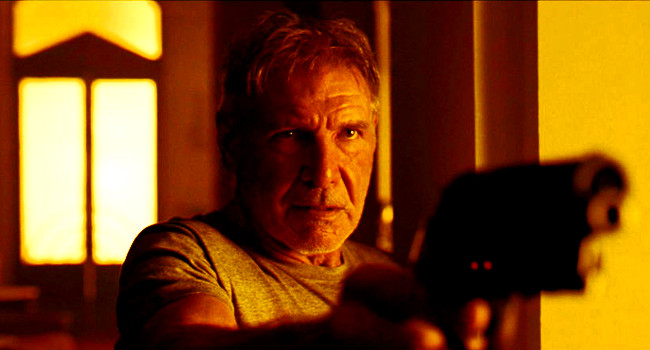I saw a media screening of Blade Runner 2049 on Monday night. Just so you know, it’s a very good addition to the Blade Runner universe that connects to the first film as well as one might ever expect. It differs from the Ridley Scott film in that it’s less of a pulp noir (especially compared to the theatrically-released version of the original), and it’s more self aware of its own philosophical reflections — but not in a manner that gets in the way of characters or stories or the insanely realized moods of this outrageously cinematic, future-fiction opera. Even thirty years after the events in the original Blade Runner, this new film is still as much about a place drenched in shadows as it is about humans and replicants, and the line that separates the two.
I’m not going to write a regular review for this exceptional movie. After the screening, Denis Villeneuve and Warner Brothers sent us off with a lengthy list of things they didn’t want us to write about even though the film’s review embargo had been lifted. With that in mind, I’m going to blast away free form at different aspects of the film as they come to mind.
Old is New Again
The moods and atmosphere of the original film are on full display here, but this is an updated version of a new new Los Angeles. Between the first movie and this film an EMP attack knocks out the power grid and erases all data, and the environmental collapse that resulted in all of the extinct animals in Blade Runner becomes a crushing famine. A new breed of reliable replicant slaves and genetically modified crops save humanity from extinction. The setting of the new film looks different to account for the changes that have occurred since the last movie, but it also looks different because of all of the advances in digital effects since Ridley Scott’s first film. Even though this new movie is a slicker product in that regard, it still maintains the gritty sense of place that the first movie captured so well, and 2049‘s viewers will feel right at home in this new film.
The characters and the acting in this new Blade Runner are consistently strong and even Gosling’s limited range is used to maximum effect here. A lot of the restrictions the filmmakers asked for limit how much I’m willing to say about the players on this new stage, but all the performances are mostly pitch perfect. Even though I thought Jared Leto’s villain was under-utilized, the new characters are great additions to the Blade Runner universe, and they’re all realized with consistently inspired performances by this contemporary cast. Again, I won’t say too much, but the returns from the original cast are very good here as well.
Denis Villeneuve’s Arrival was a very strong, but overrated alien visitation flick — it showcased the director’s visual style, but the story and some of the effects were ultimately too ham-fisted for the serious meditation on intergalactic communication that the film’s most ardent fans would have you believe it to be. Arrival is a good movie. It’s not a great film. Blade Runner 2049 is a great film, and it’s a great sequel. It’s so good that I’m afraid we’ll get another Blade Runner sequel. That film will be a disaster.
That said, if you’re planning to see Blade Runner 2049, I recommend re-watching the original. I also recommend watching these three prequel shorts to get properly oriented for this next long, strange trip…
Blade Runner 2049-”2020: Blackout”
Blade Runner 2049-”2036: Nexus Dawn”
Blade Runner 2049-”2048: Nowhere to Run”
Please subscribe to my YouTube channel where I archive all of the videos I curate at Insomnia. Click here to check out more Cinema posts








